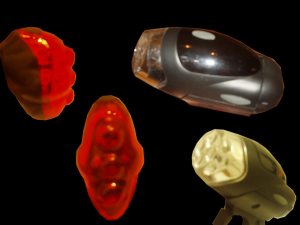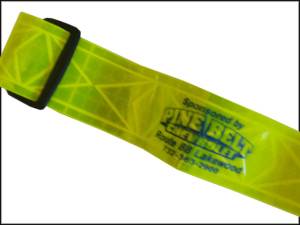|
DontGetHit Archive Page
Monday, December 31, 2012
 Whether to use a steady light on your bicycle or a flashing one is a common question for bicycle users. Whether to use a steady light on your bicycle or a flashing one is a common question for bicycle users.
A steady light can
be seen by drivers and pedestrian, but is it really as noticeable as a
flashing light? Some people may find the flashing light a little
annoying, but will the single light blend you into a sea of lights.
The answer is: as annoying as it might be, the flashing light
will attract the most attention on a busy city street. European
countries are trying to install flashing brake light on the back of cars
when the vehicle needs to stop quickly while driving 30 mph or more.
This will attract attention to the cars behind it letting them know
there is a short stop coming and danger may occur. Research shows that the flashing brake lights allow the driver in back to react and
begin pressing his brake pedal 0.2 seconds faster -- that's about one
car length at 55 mph -- and perhaps soon enough to prevent a rear-end
collision. This proves that the flashing light will attract people’s
attention a lot quicker than the steady light.
that the flashing brake lights allow the driver in back to react and
begin pressing his brake pedal 0.2 seconds faster -- that's about one
car length at 55 mph -- and perhaps soon enough to prevent a rear-end
collision. This proves that the flashing light will attract people’s
attention a lot quicker than the steady light.
However,
if you are riding down a quiet street then the flashing light might not
be necessary since there are not a lot of distractions.
All in all, if you ride on busy streets the flashing light is your best bet.
DontGetHit.com
 
Wednesday, December 26, 2012
 It
is difficult to see one another during the long, cold winter months,
especially in unlit parking lots and dark streets. Fortunately, we have
the reflective belt
to increase our visibility to vehicle traffic in these poorly lit
areas. People who work in the street during the dark hours should always
be wearing one of these belts. Even while off duty reflective wear
should always be worn to increase the visibility when walking near
traffic.
Driver visibility is increased significantly when a
pedestrian is wearing a reflective belt. More than once, you have
probably been driving through a parking lot early in the morning and
almost run over a pedestrian not wearing 
their reflective belt. Likewise, under the same conditions, you were
able to see an individual wearing their reflective belt at a safe
distance. Fortunately, the former incident did not end in a minor mishap
or worse.
No one wants to be injured or responsible for injuring
another person, especially in an accident that is preventable. We are
all responsible for taking the necessary safety precautions to prevent
mishaps. This includes wearing required personal protection equipment.
Take note of what is written in the 3rd Wing policy (3 WGI 91-202 paragraph 11) on reflective belt wear:
"Personnel
exposed to vehicle or aircraft traffic during hours of darkness or
periods of reduced visibility will be provided and use reflective
accessories or will use organizational clothing sewn-on reflective tape
(red or orange reflective colors provide better contrast in a snow or
white environment). NOTE: This applies to DoD civilian employees only
while in a paid duty status. Personnel wearing the Air Force PT uniform
either participating in, or traveling to or from fitness activities, are
exempt from wearing the reflective belt. The issued top and bottom
reflective garments must be exposed and not covered by cold weather
gear, back packs, and so forth."
Lastly, you should always give a
friendly reminder to those who are not wearing the required reflective
wear. By doing this you can prevent terrible mishap and accidents.
DontGetHit.com
 
Friday, December 21, 2012
 Walking Safety Night Visibility Walking Safety Night Visibility
There
is danger in the dark - the biggest being vehicles that don't expect
you or can't see you. Drivers cannot easily see you through fogged
windows and poor weather, and their night vision dims as they age.
Wearing a dark jacket and dark pants, you are as invisible as a ninja
during your early morning or evening walks in the winter darkness. And
what driver thinks anybody insane enough to walk in winter? We need to
walk defensively and take pains to be visible. 
Reflections
on reflectivity: Wearing reflective clothing is a good defense against
invisibility, but you need to be sure that the reflective areas are
large enough and and are exposed from every angle. Do oncoming cars see
you, but not those at side streets? Will that little reflective logo on
your shirt be enough - especially if you hide it under a jacket?
Reflective
Shoes:Most running shoes now have reflective stripes and many tout
their "360 degree reflective" features. A pair of Asics I have even
appear to have reflective soles! If your walking shoes don't have such
features, consider a pair of reflective shoelaces or put some reflective
tape on your shoes.
Reflective Clothing:Your best for finding
reflective clothing is in a running store or a bicycling shop, or the
running and bicycling sections of large sporting goods stores.
Reflective Outerwear: In winter, wearing an extra vest or a reflective jacket can also help keep you warm. DontGetHit.com has reflective vests, belts, stickers, tape, dog collars...
Reflective Vests,
Wristbands and Hats: In preparation for Portland-to-Coast, I bought
reflective velcro wristbands to wear on wrists and ankles, a reflective
sweatband and a reflective cycling hat. Walking narrow country roads at
night and being passed by 2000 vans of competitors, I didn't want
anybody to miss me, or rather I wanted them to see me and then miss me!
This was in addition to a highly reflective vest and a
lighted/reflective sash!
Tape it Up: The fastest way to become reflective is to buy reflective tape and apply it to your favorite walking garments.
Source: www.about.com
DontGetHit.com
 
Tuesday, December 18, 2012
 Crimes against women even in countries are all around the world, women's are vulnerable and especially at night.
Here are a few tips to help a women be safe if you need to be out at night.
1) Never go out at night alone, if you go with 2 or more people it deters criminals from starting up.
2)
While traveling in the evenings, stay on the main roads, were there are
people and cars, don't go off to quiet deserted roads.
3) Avoid wearing jewelry on the outside when you are out at night. Even costume jewelry might attract chain the wrong people. 
4) While walking on sidewalks, keep your handbags hidden from the public eye.
5) If you have to ask for directions, try to ask a group of people, or spot by a local gas station and ask them inside.
DontGetHit.com
 
Wednesday, December 12, 2012
Running or cycling at night has its attractions. For one, there are times of the year that it’s just not light outside when you’re not at work. During other times of the year, social and family obligations can make it late in the day before you have a chance to get outside.
As quiet and serene as nighttime cycling and running can seem, the dark carries inherent threads. Watch out for these distractions to stay safe at night.
1. Other runners or cyclists
Fellow runners and cyclists can be a big distraction, especially at night. You wonder if you know them; you check out their equipment; you wonder where they are going. If they are attractive and of the opposite sex, well...that’s another distraction. It’s not easy to identify people at night, so it takes more concentration, attention that should be focused on the road.
2. Animals
Cute or snarling, wild or tame, animals can be head-turners. Some animals, like deer, seem to come out of nowhere, especially at night. Other, tame animals are distracting because they are so adorable. Whatever the reason, don’t let animals cause you to let down your guard at night.
3. Equipment issues
Running shoes that rub, an ill-adjusted seat or a squeaky wheel can take your attention off of what’s right in front of you. Make sure that your equipment and clothing are in top shape before heading out on the road. Even the most alert runner will be distracted by growing blisters.
4. Music
Yes, listening to music makes running or cycling more enjoyable, but it also makes it more difficult for you to hear oncoming traffic, other cyclists or runners telling you to move, dogs barking or any number of threats. It’s much safer to leave your iPod or MP3 player at home.
Staying safe while running or cycling at night requires that you be a little more vigilant than you would be during the daylight hours. Make sure that you avoid distractions and wear reflective clothing, such as our variety of reflective vests. It’s also wise to make sure that you have a cell phone with you in case of an emergency, to choose well-lit routes and to vary your routine regularly, just in case someone is viewing you as a target.
DontGetHit.com
 
|